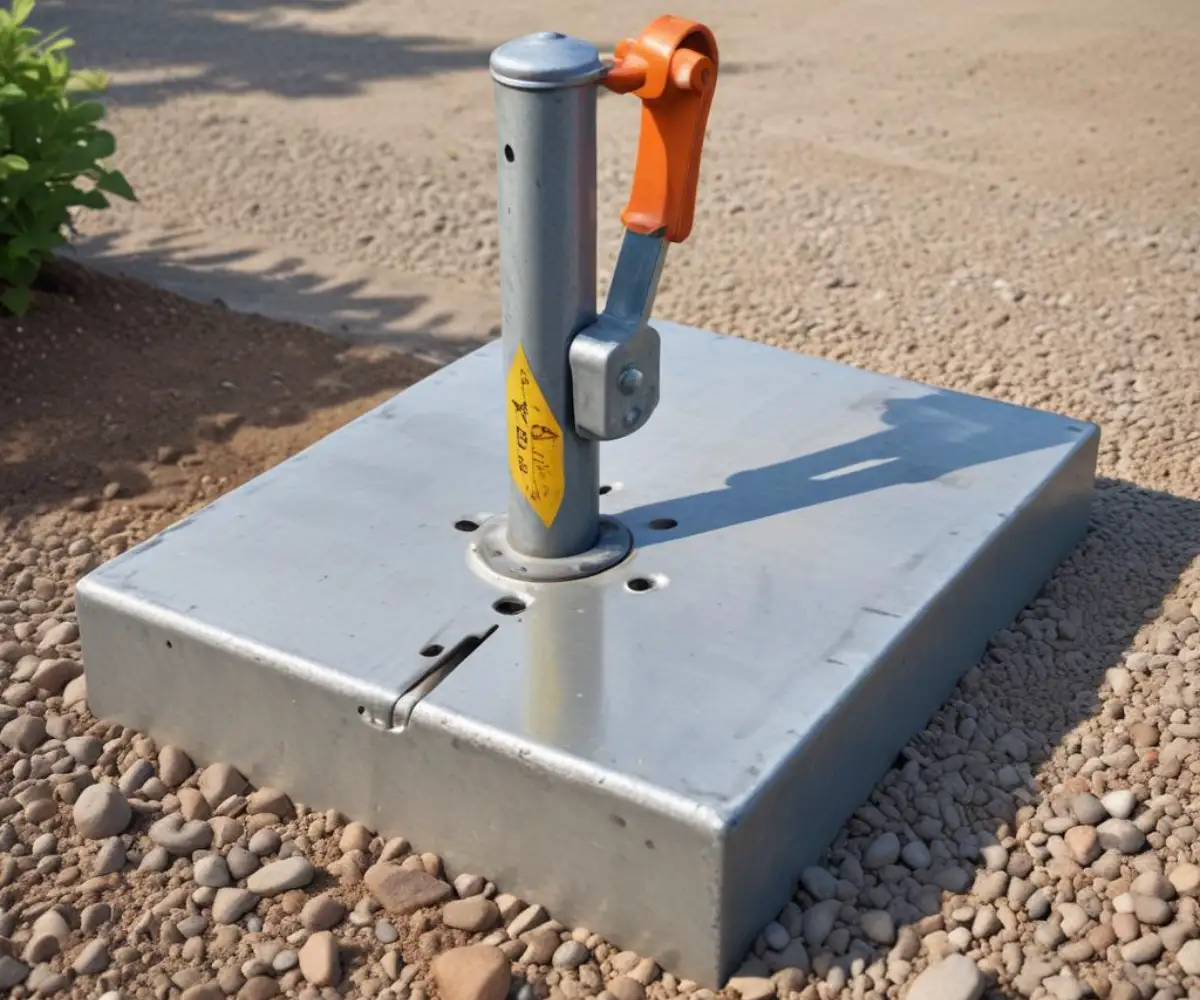Titan Deck Foot Anchor Review: Your Concrete-Free Deck Secret?
Building a deck is a rewarding project, but the thought of digging massive holes and mixing endless bags of concrete can be daunting. This traditional method is not only back-breaking and time-consuming but also leaves your yard a mess for days, if not weeks. What if there was a faster, cleaner, and equally robust way to create a solid foundation for your dream deck?
The core problem with concrete footings is the sheer labor, mess, and unpredictable curing times that can derail your project schedule. Many DIY enthusiasts and even professional builders seek a modern alternative that saves time and effort without compromising on safety or stability. This is where engineered solutions like the Titan Deck Foot Anchor enter the picture, promising a revolutionary approach to deck foundations.
You'll Learn About
What Exactly is the Titan Deck Foot Anchor?
The Titan Deck Foot Anchor is a ground screw system designed to replace traditional concrete footings for freestanding decks, sheds, and other outdoor structures. It consists of a heavy-duty, galvanized steel auger that is driven into the ground using a handheld impact wrench. This auger, combined with a load plate that sits on the surface, creates a stable and secure foundation point for your posts.
This innovative system is engineered for compression loads, meaning it excels at supporting the downward weight of a structure. The hot-dipped galvanized coating ensures long-term durability by providing excellent resistance to corrosion, even in wet soil conditions. The entire design is focused on speed and simplicity, turning what was once a multi-day job into a task that can often be completed in a single afternoon.
The Science of Stability: How it Works
The magic of the Titan Deck Foot Anchor lies in its helical design. The auger screws itself deep into the soil, compacting the earth around it and creating immense holding power. Once the auger is installed, a load plate is compressed against the ground, distributing the deck’s weight over a wide surface area, which is crucial for preventing sinking.
This system is specifically designed for freestanding structures—decks that are not attached to the house with a ledger board. This is a critical distinction because it allows the deck to “float” on the ground. In regions with frost, the ground heaves and settles seasonally; a floating deck built on these anchors will move uniformly with the ground, preventing the structural stress that can damage a ledger-attached deck.
The #1 Concern: Strength and Reliability vs. Concrete
The most significant hesitation for anyone considering a concrete alternative is whether it can truly match the strength of a traditional footing. Can a metal screw in the ground really support an entire deck, complete with furniture, a grill, and people? The engineering and testing behind the Titan Deck Foot Anchor provide a confident answer.
Independent testing has shown that a single 4×4 Titan Deck Foot Anchor can support a compression load of up to 15,000 lbs, and the 6×6 version up to 19,000 lbs. This capacity far exceeds what the soil itself can typically bear. The true limiting factor is not the anchor, but the soil’s bearing capacity. Understanding your soil is the most critical step toward a successful installation.

Soil Type is Everything: The Key to a Rock-Solid Foundation
The performance of the Titan Deck Foot Anchor is entirely dependent on your soil conditions. This is the most crucial variable for success. Dense, stable soils like clay and compacted sandy gravel provide excellent resistance for the auger, resulting in a very secure footing. Looser, sandy soils may require longer augers to achieve sufficient uplift resistance.
Conversely, soil filled with large rocks, dense roots, or other obstructions can make installation impossible. It’s highly recommended to test your soil before purchasing the anchors. A simple way to do this is by driving a long 1″ spade bit into the ground in your planned footing locations. If you can drill down 24 inches or more without hitting major obstacles, the anchors will likely work for you.
Step-by-Step Installation: A No-Nonsense Guide
One of the biggest selling points of the Titan Deck Foot Anchor is its remarkably simple installation process. With the right tools and proper site preparation, you can set all your footings and start building your deck frame on the same day.
Tools and Preparation
Before you begin, gather your tools. You will need a powerful ½” handheld impact wrench (not a drill/driver), a 12mm six-point socket for the auger head, and a 24mm deep impact socket for the compression nut. You’ll also need a level, measuring tape, and string lines to lay out your footing locations accurately.
Site preparation is simple but vital. Clear away all sod and organic material in an 18″ x 18″ area for each footing. Level the ground and add a 3-inch layer of crushed stone, tamping it down firmly. This creates a stable, porous base that promotes drainage and prevents soil erosion around the footing.
The 3-Step Installation Process
1. DRIVE: Position the auger in the center of your prepared area. Using the impact wrench and 12mm socket, drive the auger into the ground. Keep the auger as plumb (vertically level) as possible during installation.
2. TIGHTEN: Once the auger is fully driven, place the load plate over the top. Use the 24mm socket to tighten the compression nut, which presses the load plate firmly against the ground until it’s secure.
3. ATTACH: Place the post saddle in your desired position on the plate. A key feature is that the saddle is laterally adjustable, giving you flexibility if your auger didn’t go in perfectly straight. Tighten the top nut to lock the saddle in place, and you’re ready to set your post.
Titan Deck Foot Anchor vs. Traditional Concrete Footings
To truly understand the value proposition, a direct comparison is essential. Both methods can result in a safe, stable deck, but the journey to get there is vastly different. The choice often comes down to balancing factors like cost, labor, time, and site conditions.
| Feature | Titan Deck Foot Anchor | Traditional Concrete Footing |
|---|---|---|
| Installation Time | Minutes per footing | Hours or days per footing (including curing) |
| Labor Intensity | Low; requires an impact wrench | Very high; involves digging, mixing, pouring |
| Mess & Cleanup | Minimal; no excavated soil or concrete mess | Significant; soil piles, concrete spillage |
| Weather Dependency | Can be installed in most weather | Pouring concrete is difficult in rain or freezing temps |
| Adjustability | Easily reversible and repositionable | Permanent and unforgiving once poured |
| Cost | Higher initial product cost | Lower material cost, but higher labor/time cost |
| Soil Suitability | Best in soil free of large rocks/roots | Universally applicable; can dig out obstructions |
Real-World Applications: More Than Just Decks
While “deck” is in the name, the versatility of the Titan Deck Foot Anchor extends to a wide range of outdoor projects. Its speed and simplicity make it an ideal foundation solution for any freestanding structure where you want to avoid the hassle of concrete.
These anchors are perfect for creating a solid base for sheds, pergolas, gazebos, ramps, and even small cabins or playhouses. For instance, when planning a rot-proof foundation for a shed, using these anchors can elevate the structure off the ground, promoting air circulation and preventing moisture damage to the floor frame. The ability to build close to the ground (as low as 2 inches) offers design flexibility that is difficult to achieve with traditional deck blocks.
The Hidden Pitfalls: What Could Go Wrong?
No product is perfect, and the Titan Deck Foot Anchor is no exception. Success is heavily reliant on proper use and suitable conditions. The most common issue users face is hitting an immovable object like a large rock or a dense tree root. If this happens, you must reverse the auger and try a slightly different location.
Another potential pitfall is using an underpowered impact wrench, which may not have enough torque to drive the auger fully into dense soil. It’s also critical to use the correct size six-point sockets; a twelve-point socket or an incorrectly sized one can strip the drive head on the auger. Finally, remember that these anchors are not designed to resist significant lateral (sideways) forces, making them unsuitable for projects like freestanding fence posts or standalone support for a shade sail.
Load Capacity and Code Compliance: Is It Up to Snuff?
The impressive load ratings are a key feature, but you must always consider your local building codes. The Titan Deck Foot Anchor has a Code Compliance Research Report (CCRR-0495) which can be submitted to local building authorities. It is generally permissible under IRC guidelines for freestanding decks.
However, it is crucial to understand that these anchors are not a solution for decks attached to a house ledger in frost-prone areas. A ledger-attached deck must have footings that extend below the frost line to prevent movement, which the standard Titan Deck Foot Anchor is not designed for. When considering the structural integrity of your deck, factors like post size are also critical; for example, understanding the limitations and risks when deciding whether you can use 4×6 lumber for deck posts is an essential part of a safe design.
Cost Analysis: Is the Titan Deck Foot Anchor Worth the Money?
At first glance, the upfront cost of a Titan Deck Foot Anchor is higher than a bag of concrete and a sonotube. However, a true cost analysis must factor in the value of your time, the cost of labor, and potential tool rentals. The time saved is often the most significant financial benefit.
A project that might take two full weekends with concrete could potentially be completed in one with these anchors. This means less time off work or more time enjoying your finished deck. When you eliminate the need to rent a concrete mixer or pay for delivery, the cost difference narrows considerably. For many, the convenience and speed are well worth the premium price.
Expert Verdict: The Final Word on the Titan Deck Foot Anchor
The Titan Deck Foot Anchor is an outstanding innovation for the right project. It offers a legitimately fast, clean, and robust alternative to concrete for freestanding decks, sheds, and similar structures up to 6 feet in height. Its high load capacity and ease of installation make it a game-changer for DIYers and professionals alike.
However, its effectiveness is entirely conditional. It is not a universal replacement for concrete. You must have suitable soil conditions, free from major obstructions. You must use it for a floating structure, not one attached to your house in a frost zone. And you must use the proper tools for a successful installation.
If your project fits these criteria, the Titan Deck Foot Anchor is an excellent choice that will save you an immense amount of time, effort, and mess. It delivers on its promise of strength and security, allowing you to build a durable, reliable foundation in a fraction of the time. It is a modern solution that effectively solves the age-old problem of difficult deck footings.

